Abstract
Antibody formation to sheep erythrocytes, as detected both at the cellular and humoral level, was suppressed in adult mice after reticulo-endothelial cell (RES) blockade induced by intraperitoneal injection of colloidal carbon. Fewer antibody plaque-forming cells (PFC) appeared in spleens of carbon pretreated mice as compared to normal controls following intraperitoneal immunization with sheep erythrocytes. The day of peak antibody response was the same, however, for both control and carbon treated animals.
There was no compensatory increase in the number of PFCs in other lymphoid organs of carbon treated animals. Similarly, carbon inoculation had no detectable effect on the number of `background' PFCs in the spleens of unstimulated mice.
The time of injection of carbon in relation to time of immunization influenced the effect since injection of carbon 24–48 hours prior to RBC injection resulted in maximum immunosuppression. Injection of carbon 4–5 days before red blood cells resulted in only partial immunosuppression. Treatment with carbon 1–2 weeks prior to immunization had no detectable effect. Similarly, injection of carbon 1 or 2 days after immunization had little or no effect on the peak plaque response.
The decrease in the amount of serum antibody to sheep red blood cells in carbon treated mice was not as marked as that which occurred on the individual cell level. However, most of the antibody in the sera of carbon treated animals was susceptible to 2-mercaptoethanol, even 1 or 2 weeks after immunization. On the other hand, serum antibody from control mice was mainly 2-mercaptoethanol sensitive only during the first week after immunization.
Immunosuppression seemed to be related to a direct effect of carbon since the supernatant fluid obtained from carbon suspensions was not suppressive. Also, washed or dialysed carbon preparations were just as effective as the original preparation in suppressing antibody responses.
Full text
PDF



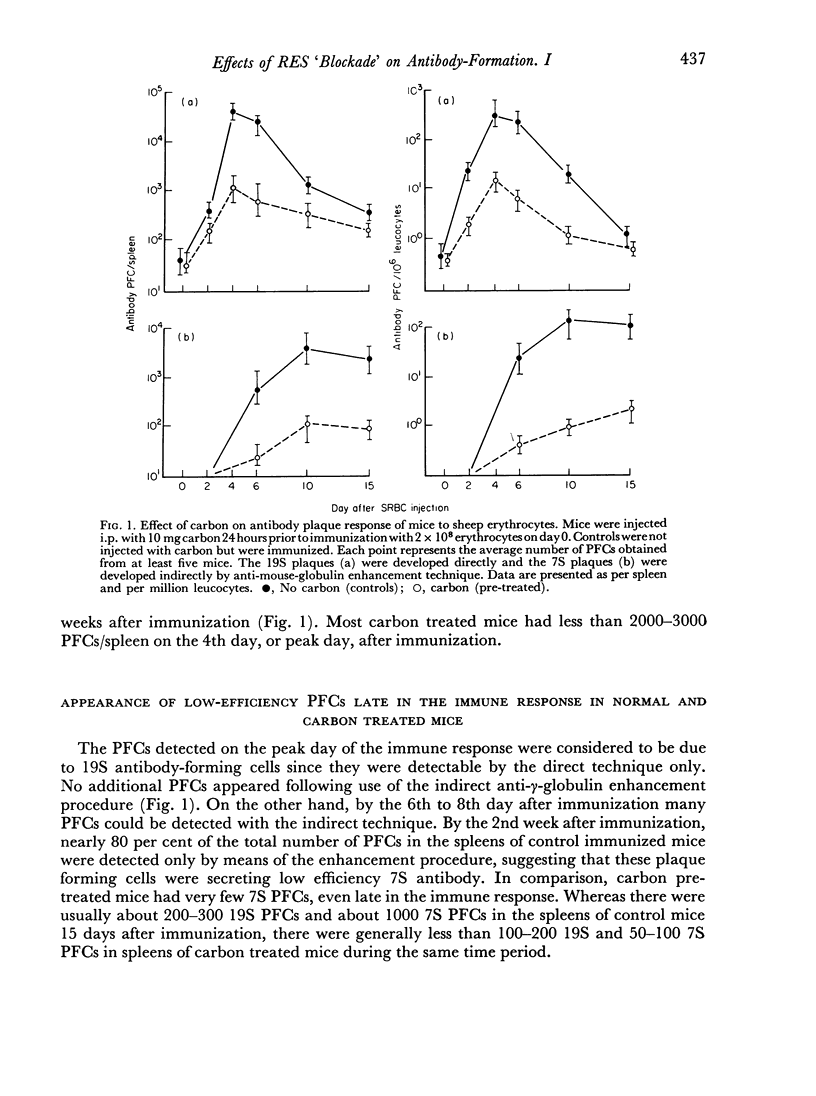
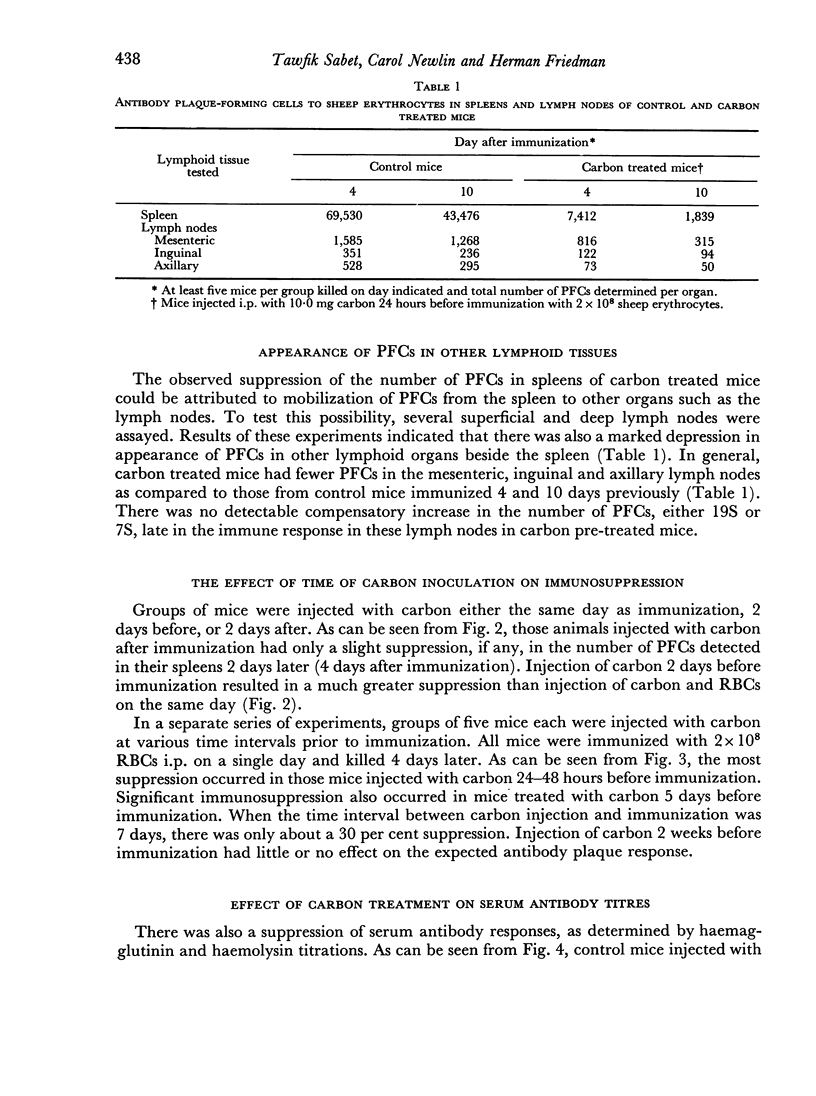
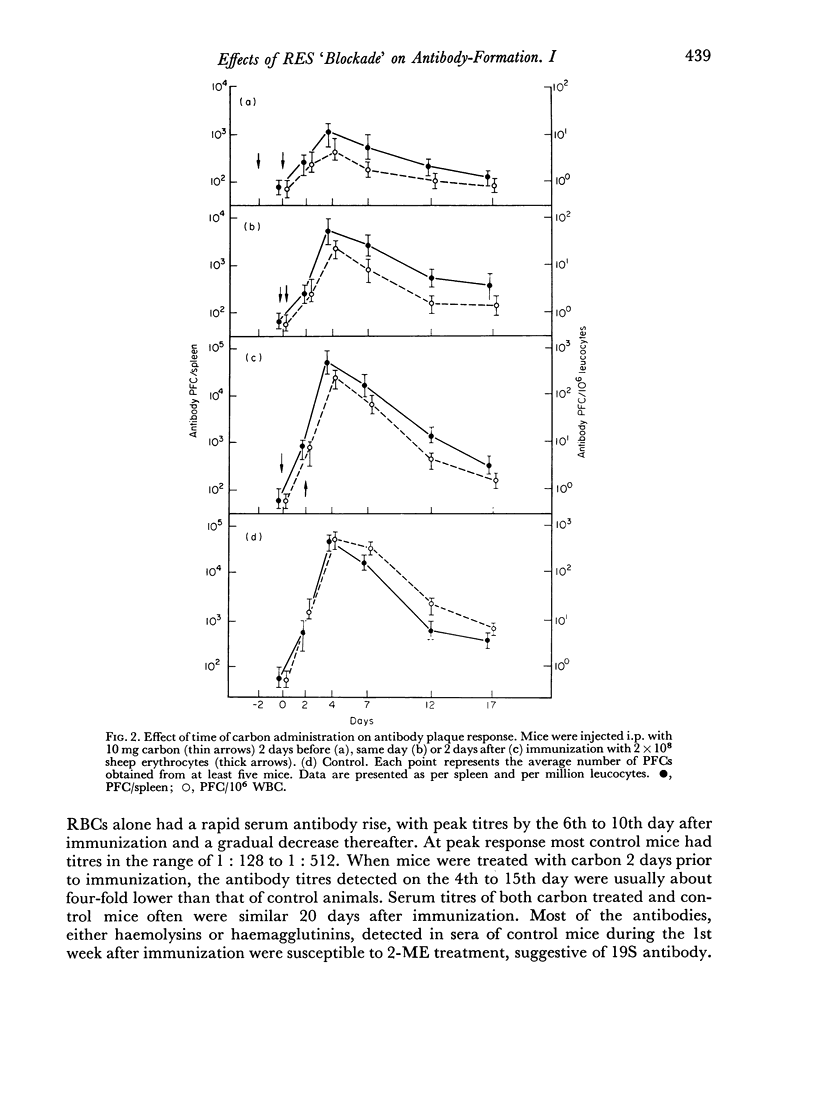
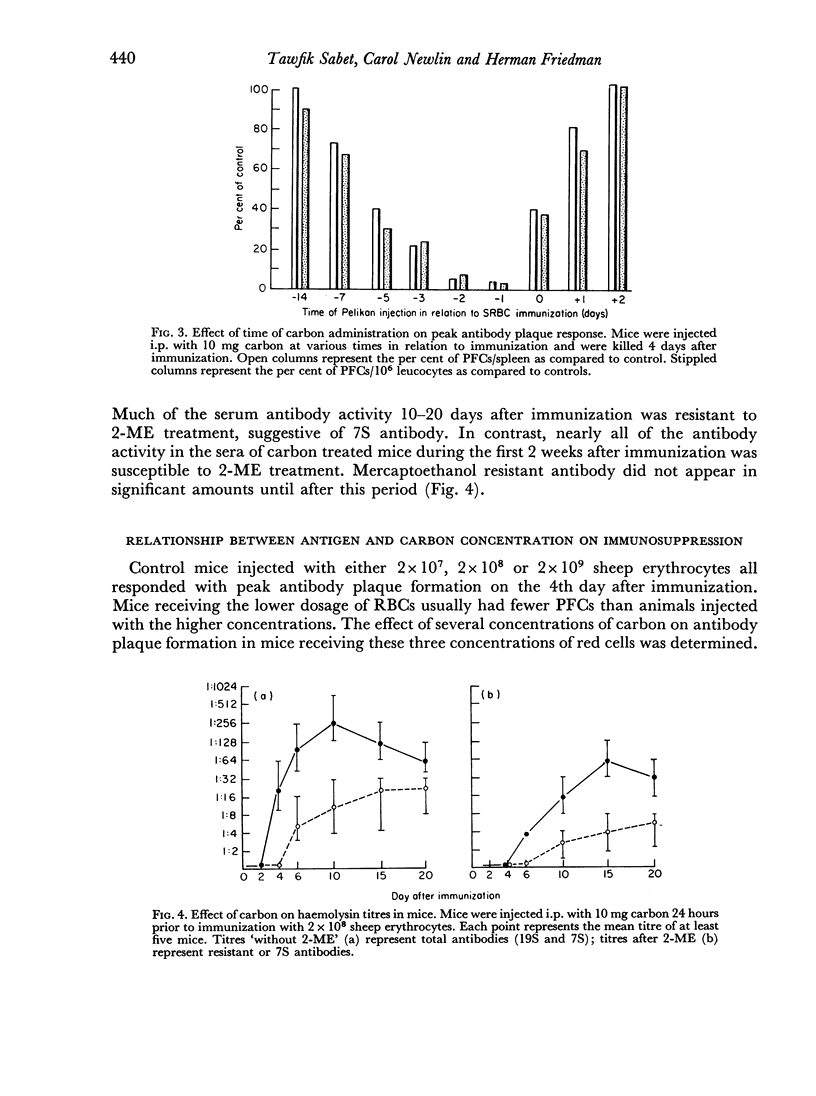
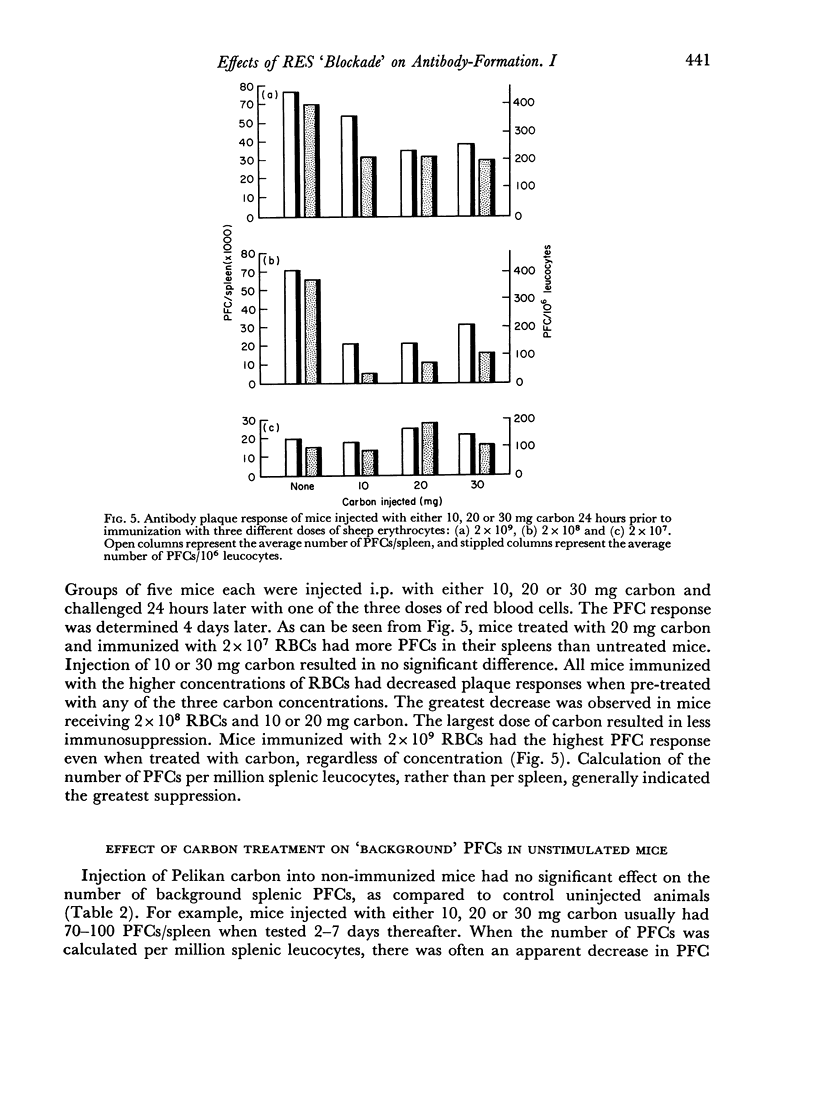


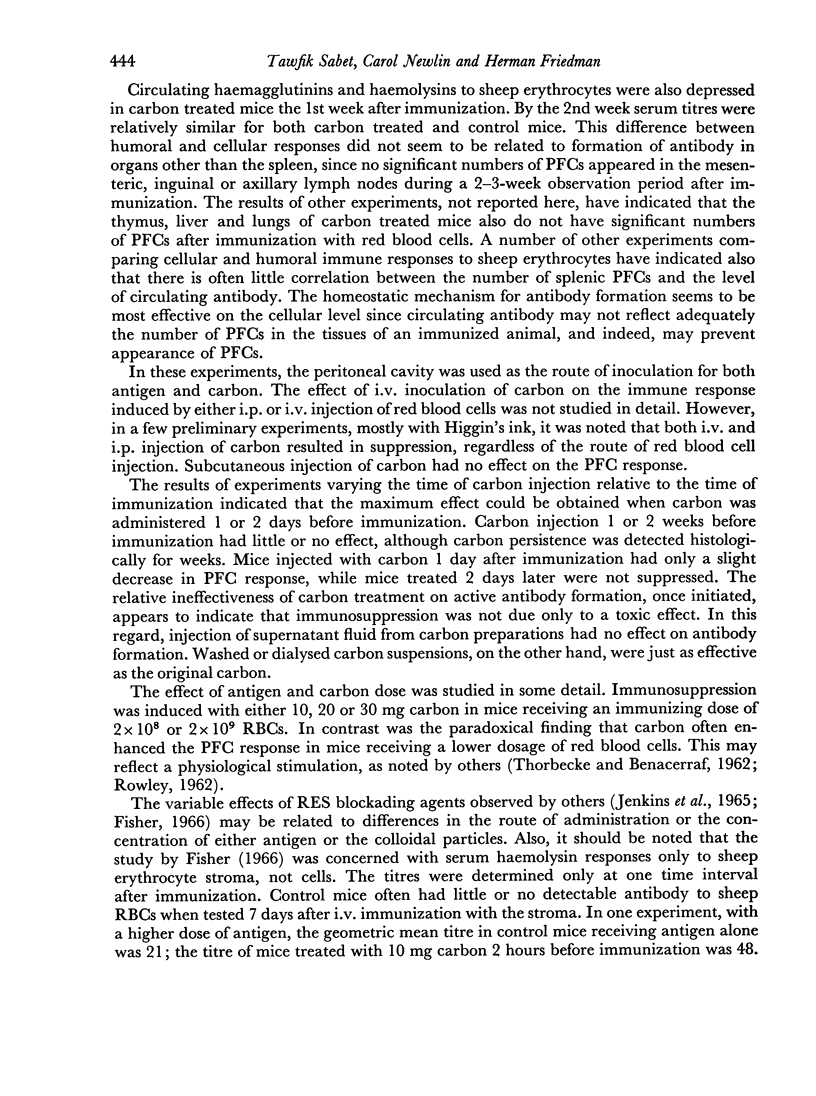


Selected References
These references are in PubMed. This may not be the complete list of references from this article.
- BIOZZI G., BENACERRAF B., HALPERN B. N. Quantitative study of the granulopectic activity of the reticulo-endothelial system. II. A study of the kinetics of the R. E. S. in relation to the dose of carbon injected; relationship between the weight of the organs and their activity. Br J Exp Pathol. 1953 Aug;34(4):441–457. [PMC free article] [PubMed] [Google Scholar]
- DERBY B. M., ROGERS D. E. Studies on bacteriemia. V. The effect of simultaneous leukopenia and reticuloendothelial blockade on the early blood stream clearance of staphylococci and Escherichia coli. J Exp Med. 1961 Jun 1;113:1053–1066. doi: 10.1084/jem.113.6.1053. [DOI] [PMC free article] [PubMed] [Google Scholar]
- Dresser D. W., Wortis D. H. Use of an antiglobulin serum to detect cells producing antibody with low haemolytic efficiency. Nature. 1965 Nov 27;208(5013):859–861. doi: 10.1038/208859a0. [DOI] [PubMed] [Google Scholar]
- FRIEDMAN H. DISTRIBUTION OF ANTIBODY PLAQUE FORMING CELLS IN VARIOUS TISSUES OF SEVERAL STRAINS OF MICE INJECTED WITH SHEEP ERYTHROCYTES. Proc Soc Exp Biol Med. 1964 Nov;117:526–530. doi: 10.3181/00379727-117-29628. [DOI] [PubMed] [Google Scholar]
- Fisher S. Stimulation of splenic antigen uptake and of antibody response in mice by India ink or other "blockading" agents. Immunology. 1966 Aug;11(2):127–136. [PMC free article] [PubMed] [Google Scholar]
- Friedman H. Immunological tolerance to microbial antigens. II. Suppressed antibody plaque formation to Shigella antigen by spleen cells from tolerant mice. J Bacteriol. 1966 Oct;92(4):820–827. doi: 10.1128/jb.92.4.820-827.1966. [DOI] [PMC free article] [PubMed] [Google Scholar]
- Hirsch J. G. Phagocytosis. Annu Rev Microbiol. 1965;19:339–350. doi: 10.1146/annurev.mi.19.100165.002011. [DOI] [PubMed] [Google Scholar]
- Jenkin C. R., Auzins I., Reade P. C. The synthesis of macroglobulin antibody to a bacterial antigen in mice after treatment with thorotrast. Aust J Exp Biol Med Sci. 1965 Oct;43(5):607–624. doi: 10.1038/icb.1965.46. [DOI] [PubMed] [Google Scholar]
- KOENIG M. G., HEYSSEL R. M., MELLY M. A., ROGERS D. E. THE DYNAMICS OF RETICULOENDOTHELIAL BLOCKADE. J Exp Med. 1965 Jul 1;122:117–142. doi: 10.1084/jem.122.1.117. [DOI] [PMC free article] [PubMed] [Google Scholar]
- LEWIS L. A. Effect of repeated injections of thorotrast on antibody production. Am J Physiol. 1954 Nov;179(2):285–286. doi: 10.1152/ajplegacy.1954.179.2.285. [DOI] [PubMed] [Google Scholar]
- STERN K., SPENCER K., FARQUHAR M. Effect of polyvinyl pyrrolidone on immune response in mice. Proc Soc Exp Biol Med. 1955 May;89(1):126–131. doi: 10.3181/00379727-89-21735. [DOI] [PubMed] [Google Scholar]
- Stern K., Bartizal C. A., Divshony S. Changes in reticuloendothelial phagocytosis in mice with spontaneous tumors. J Natl Cancer Inst. 1967 Apr;38(4):469–480. [PubMed] [Google Scholar]
- Sterzl J., Ríha I. Detection of cells producing 7S antibodies by the plaque technique. Nature. 1965 Nov 27;208(5013):858–859. doi: 10.1038/208858a0. [DOI] [PubMed] [Google Scholar]
- THORBECKE G. J., BENACERRAF B. The reticulo-endothelial system and immunological phenomena. Prog Allergy. 1962;6:559–598. [PubMed] [Google Scholar]
- WOOD W. B., Jr Phagocytosis, with particular reference to encapsulated bacteria. Bacteriol Rev. 1960 Mar;24(1):41–49. doi: 10.1128/br.24.1.41-49.1960. [DOI] [PMC free article] [PubMed] [Google Scholar]
- Wortis H. H., Taylor R. B., Dresser D. W. Antibody production studied by means of the LHG assay. I. The splenic response of CBA mice to sheep erythrocytes. Immunology. 1966 Dec;11(6):603–616. [PMC free article] [PubMed] [Google Scholar]


